  |
|||||||
2001 and a long afternoon in the dark.
Having read with interest many blogs and web sites about the Kubricks film 2001 a Space Odyssey I feel I must put in my penny's worth to the information about this film.
It must be impossible for anyone who has only seen 2001 on video or DVD to imagine what the fuss is all about with this film. For a generation brought up on Star Wars it must seem very odd. Also unless you have seen it in the original full Super Panavision and surround sound on a giant screen it certainly looses it impact.
|
|||||||
Its almost impossible to relate the impact 2001 had at the time. It was not what is now termed a blockbuster there was little pre release hype, there was however interest after and I do remember at least two perhaps three BBC documentaries about it at the time, one about the special affects and one an interview with the guy who played the lead monkey. I'll come back to these.
Its often said that if you saw the original time will have dimmed the memory of details, that may be true about some of it, it was a bloody long film. But there are parts that did defiantly stick especially with me but why should that be. |
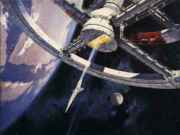 |
||||||
It was 1968 I was in my early twenties and like everyone then into space technology. This was the heat of the space race,(First man in space Yuri Gagarin was only in 1961 and America was now about to put the first man on the moon.), I was also seriously into photography, films and model making. I was in London on holiday and wondering around one afternoon seeing what shows were on to see that evening. I passed this cinema with pictures of fabulous looking space ships on it. This was long before computer graphics, these were not even paintings they were stills from the film they were models. They were very impressive models, not like the sort of thing normally seen in science fiction films at the time. The manatee was about to start so on the spur of the moment I went in.
I bought the saviour programme (below) which although very nice I was disappointed with it, there were very few pictures of the space ships and it was pretty expensive. |
|||||||
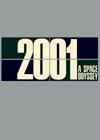 Click on above for link to site showing the whole programme. |
Alot is talked about the length of the premier showing and yes it was long but at this time it was common to see two films an A film the main one and then a B film and a Newsreel which often totalled up to the length of 2001.
I have read that the film was split into two sessions. This was not the case with the film I saw and a two split does not make a lot of dramatic sense unless a lot was cut from the first part.
This screening in London in 1968 of 2001 was split into three sessions with two intervals for a loo break and a cup of tea or ice-cream. These intervals were part of the film and integrated like TV commercials at a climax point of each part. |
||||||
|
I am not going to relate the whole film others have done that (see links below) I'm only going to concentrate the few impact points and scenes at the climax points of the film that I know is missing.
1968 A Film Odyssey
The first third of the film was about the monkeys, virtually a silent film, the earth was going through a drought and the monkeys were starving, there were other animals and monkey groups all competing for the vegetation. The monolith appears the monkeys suddenly learn that they can kill and eat the animals. A byproduct of this however was that they take the ability to kill for food with them in angary confrontation with their own kind. One of them kills a rival and in anger hurls the bone he has done this with high into the air. This is the now well known change sequence when the bone goes up and up and morphs into a space probe.
What a relief after all those monkeys to finally get to the space bit.
|
|||||||
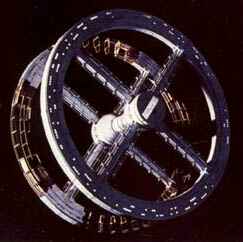 |
There are a few different space vehicles each slightly more elaborate indicating passing of time then we see the final ship, a space shuttle with the logo Pan America. The camera angle changes and we see the shuttle is heading for a wheel shaped space station, interestingly with part of it still being built.
At this point the first intermission begins and the curtains close over the huge cinema screen with the music of the Blue Danube playing.
Time for the loos and get some drink and an ice-cream after the heat of that desert. |
||||||
|
Now this is an important bit so pay attention.
This was one of the sequences one does not forget and can only be appreciated on a giant screen. The music of the Blue Danube begins again, the lights go out and there is a black screen, then stars appear, and they are rotating, the are rotating for a long time, it is very hypnotic. You feel the cinema going the other way. Its black and the only points of light you can see in front of you are rotating. (This is one of the sequences that have been shortened, it would make no sense at all on a small screen)
Gradually you begin to realise the frame of the screen is getting smaller narrowing to a rectangle in the middle of the screen, the rectangle is not rotating but the stars within it are.
|
|||||||
 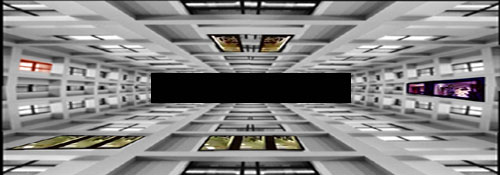 |
Then comes one of the most mind blowing sequences of the film, the camera keeps pulling back and you realise you are inside the docking bay at the centre of the rotating space station. You can see the rectangular walls on all four sides of the bay and there are windows. |
||||||
The mind blowing part was that there were rooms behind the windows on all sides of the docking bay, each with people in the going about their business, walking about talking doing things. ( It would not have been any good if they had been standing still or sitting) This had never been seen before, they were real people and camera was moving. This was not all done with mirrors. This was something new. This made up for all those monkeys. This sequence may have been cut for smaller screens as you needed a high level of detail fo make this look as impressive as it was. This process of people within the moving models was repeated with the ship going to the moon and later on within the lunar buss. |
|||||||
|
This part of the film was what a si-fi fan wanted and something never before attempted. Long slow shots of spacecraft in great detail, designed and thought out by people who knew something about space ships and what they might look like in the future. (Then 30 years in the future.)
Gallop along to the now to the next and probably the most important cut in the entire film. Pool has been shut out of the space ship. To get back in he has blown the hatch on his pod and been blown into an emergency pressure chamber on the mother ship. He activates the emergency re-pressurising system and is saved. |
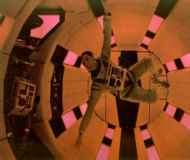 |
||||||
|
At this point there was another intermission the curtains close and the house lights went up. This middle section was the best bit of the film. It was a very serious attempt at depicting space flight. The spaceships were futuristic with believable systems and equipment and it was all played out very slowly. There were no wars, lazier guns or clashes of personality with an egotistical crew, the only threat was the cold computer.
Now this is another important bit so pay attention.
Following the intermission there is a sequence of the film missing, why this was cut I cannot imagine as it was in fact the lead up to the climax of the film. The lights go down and the is no music only the forced sound of breathing this goes on the dark for a time then lights flicker on and we have a close up of Pools face in a space suit helmet, it is his breathing we have been listening to. The camera goes to a long shot as enters through a hatch into the storage passage. Here the camera tracks backward as Pool walks down the corridor keeping a full length view of him as he moves down the passage. All we hear is Pools breathing and from time to time HAL trying to talk to Pool asking him what he is going to do, pleading with him to talk about the mission, that the mission cant go on without him. This goes on while Pool walks down three or four sections of the storage passage each delineated by Pool having to step over a bulkhead. This sequence went on for at least five minutes as the suspense built up as we did not know what Pool was going to do either, or whether HAL could stop him. The was no music building up suspense, Pools breathing did not change and HALs voice did not change tone. It was the total lack of cinematic tricks that made the tension so palpable. |
|||||||
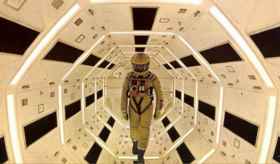 |
Why should I remember this scene so well, for starters it was after an interval and was built up to, like the rotating stars after the first interval. Second it was the climax of the space story, the only man left what was he going to do. Thirdly and quite importantly for me at least, I could not see how this scene was shot. It was a long passage filmed in one sequence without any cuts. It was a confined enclosed set with narrow ceiling, walls and floor, the floor was uneven, then there were those bulkheads. It was too long for a crane shot, zoom lenses had not been invented and the steady cam was only a dream. |
||||||
|
This long passage was also important logistically, as at the end of it Pool enters a chamber then climbs up into the computer memory room. This places the core of HAL in the centre of the ship underneath the communications dish array. This makes alot of sense, the computer was in the cold, midway between the engine and the crew. 
Pool climbs into the memory room and removes HALs higher functions and the computer dies singing daisy daisy , which at the time the film came out was well known because the television news programs like tomorrow's world had been full of the first computer to synthesise speech. The fist thing demonstrated to the news press was the computer singing daisy daisy. This was, I am sure, a subtle joke or homage by Clark.
Ever since seeing that first version of 2001 I have been looking for a version with this, what I consider in important, scene still in. It was only relatively recently with the Internet that I discovered how much had been cut. I don't know who cut this scene but I doubt if it was Kubrick. |
|||||||
The Documentaries
In all the things I've read on the Internet I have not come across anyone who mentions the BBC documentaries. The one I remember most of all was one which dealt with the special effects. They Interviewed the guys who did these and showed the models, one was standing beside the spaceship discovery, which was about twelve feet (4 m) long. He talked about photographing this large model using small stopped (high f numbers) lenses to get the depth of field so that whole thing was in focus and how using a single spotlight as the sun giving so little light that he had to use five minute to ten minute exposure for each frame of film. These interviews must have been quite soon after the film was released as Kubrick had the models destroyed so they could not be used again. |
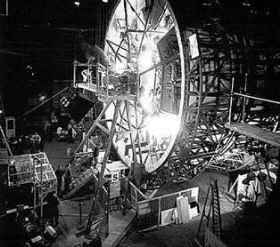 |
||||||
Also in this program the special effects man showed us the travelling mat camera they had designed especially for this film that allowed those wonderful images of people within moving spacecraft. |
|||||||
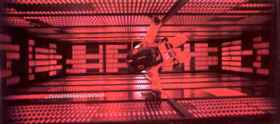 |
The Mystery of HAL
One of the small mysteries that have cropped up was the chose of name for HAL. It was often said that Clark picked the previous letters of the alphabet from IBM i.e. H for I, A for B, L for M. Clark however always avoided confirming this.
|
||||||
It was not untill a few months ago that I think I came across what I think is the answer, Clark was a great one for referencing, hence the daisy daisy song. What I came across was a recently restored version of the original Metropolis, a 1926 film always held up an innovating masterpiece. It was here I think the answer was, the scientist who helped build Metropolis, Rotwang, made a Robot to that was replace his dead lover. This robot was eventually to go mad and destroy Metropolis. The robot was named after the Scientist's dead wife Hel.
I am sure Clark would have loved this back link to this silent science fiction film. He couldn't call the computer in 2001 HEL this would be signalling (as it is prnounced hell) the evil core of the machine. Metropolis was a German film and Hel was short for Helena. Clark simply called the computer HAL simply changing the E for an A. Clark would have known the film Metropolis and I can see why he would never let on, there would be too much speculation and comparison between the two stories. But he was always amused when ask about HAL.
|
|||||||
| Best links about 2001 so far found. Palantir - Great series of photos from film Starship Modeler - Good links and information about models The Underview Links - Large 2001 resource Original Program - Showcases the printed Saviour Program. |
|||||||
A Tony on the Moon site |
|||||||